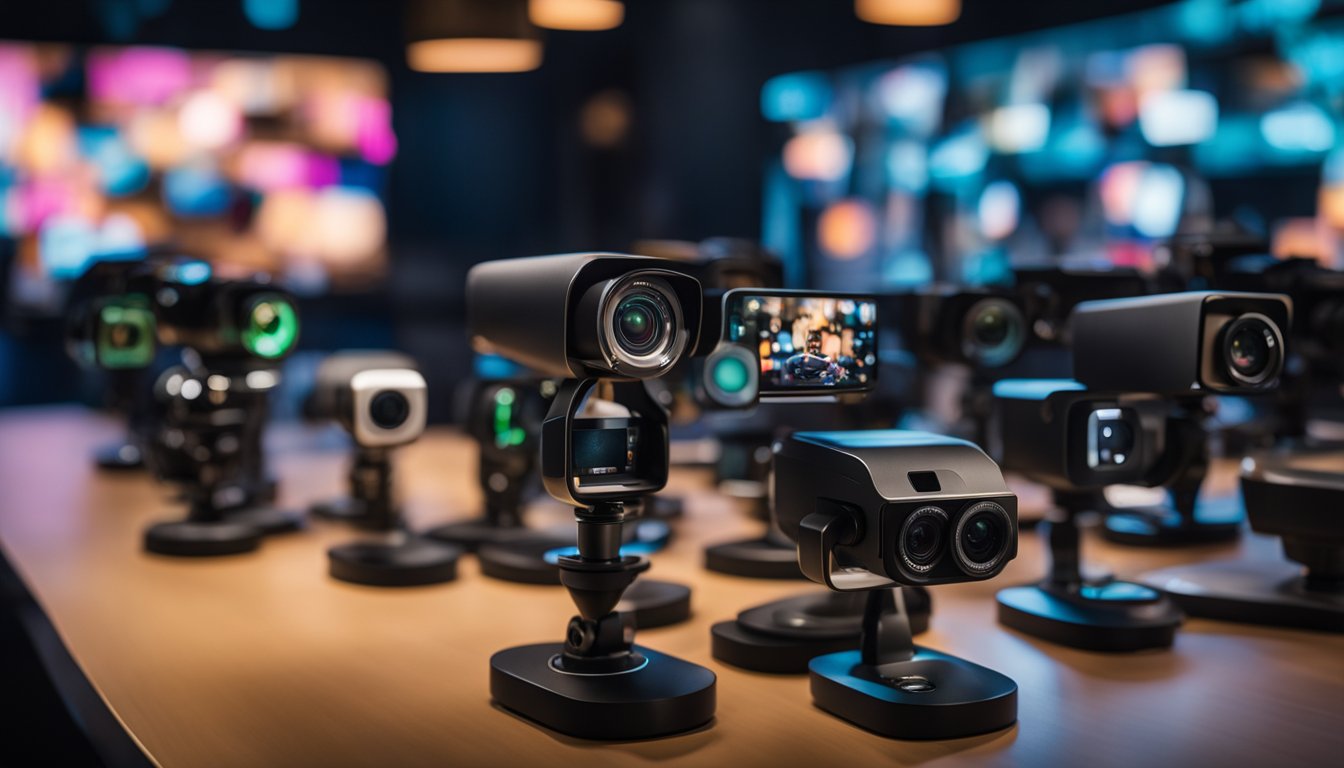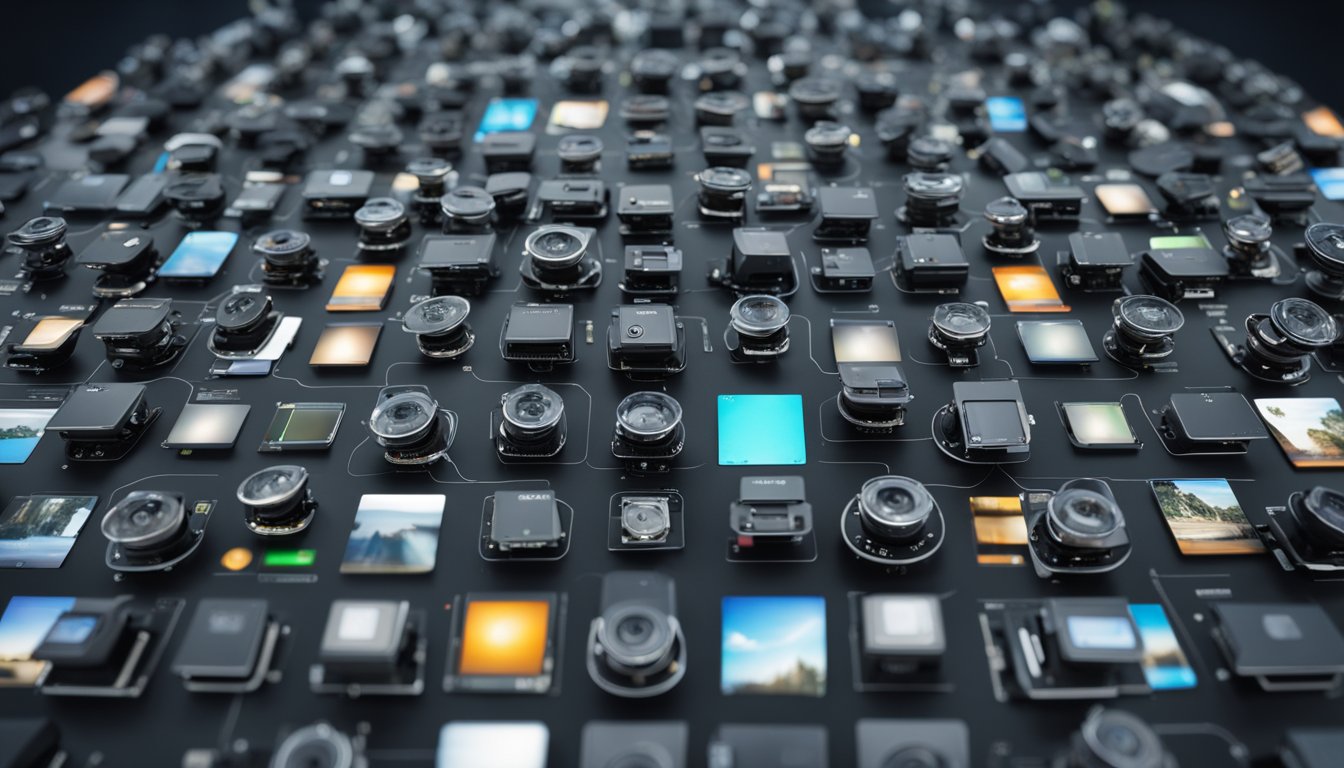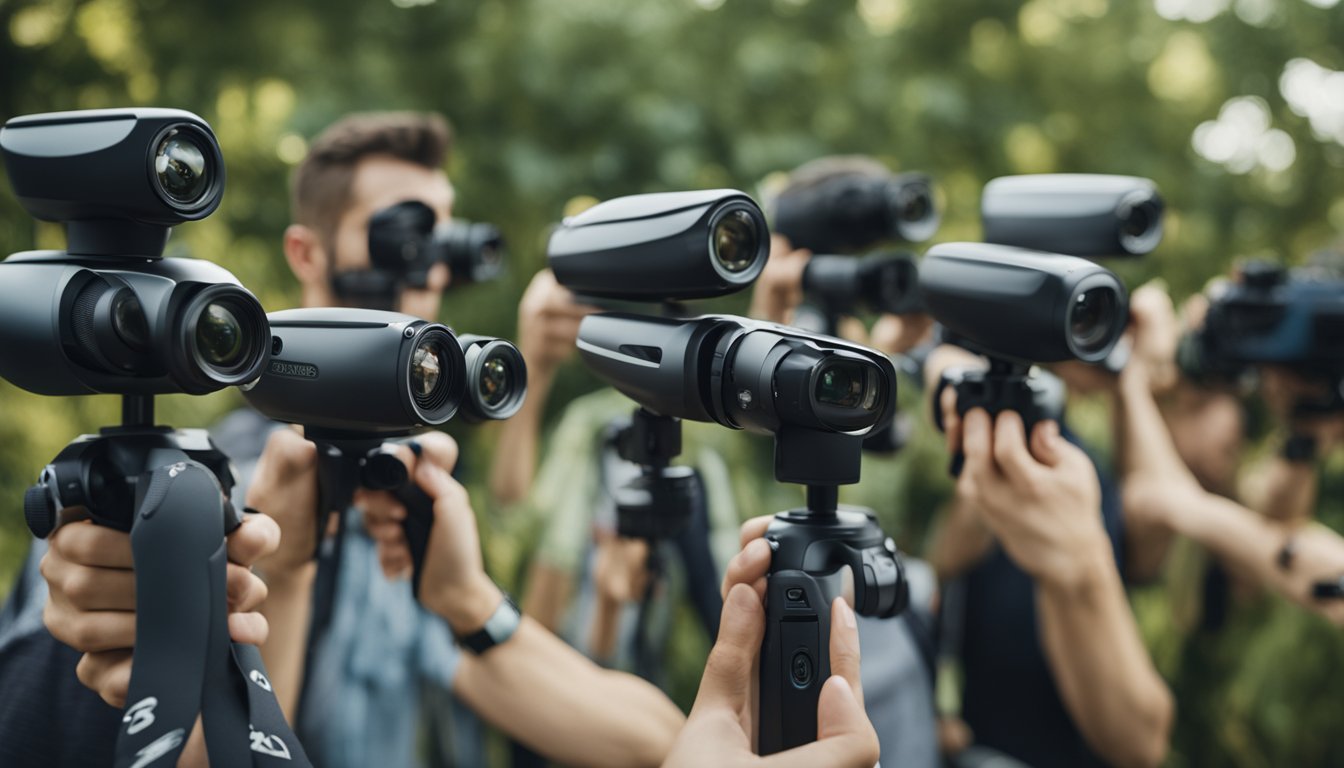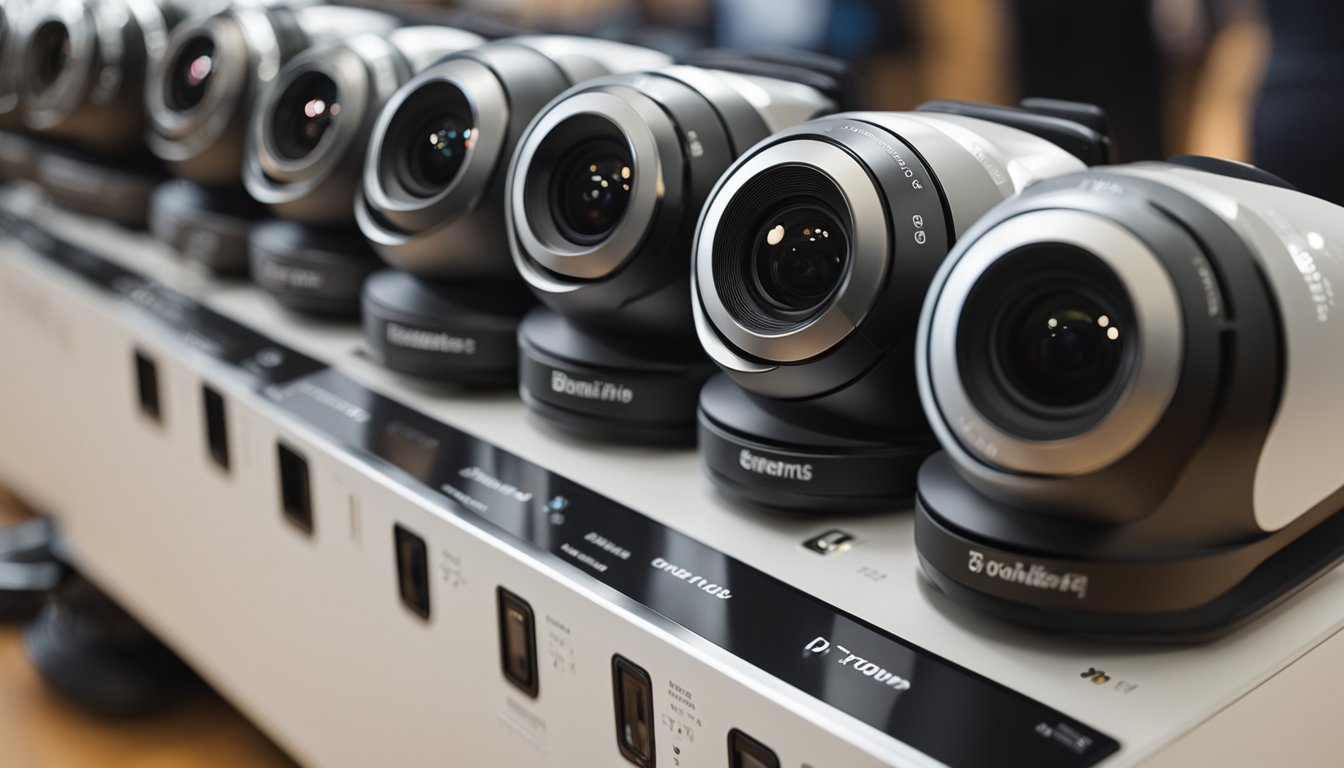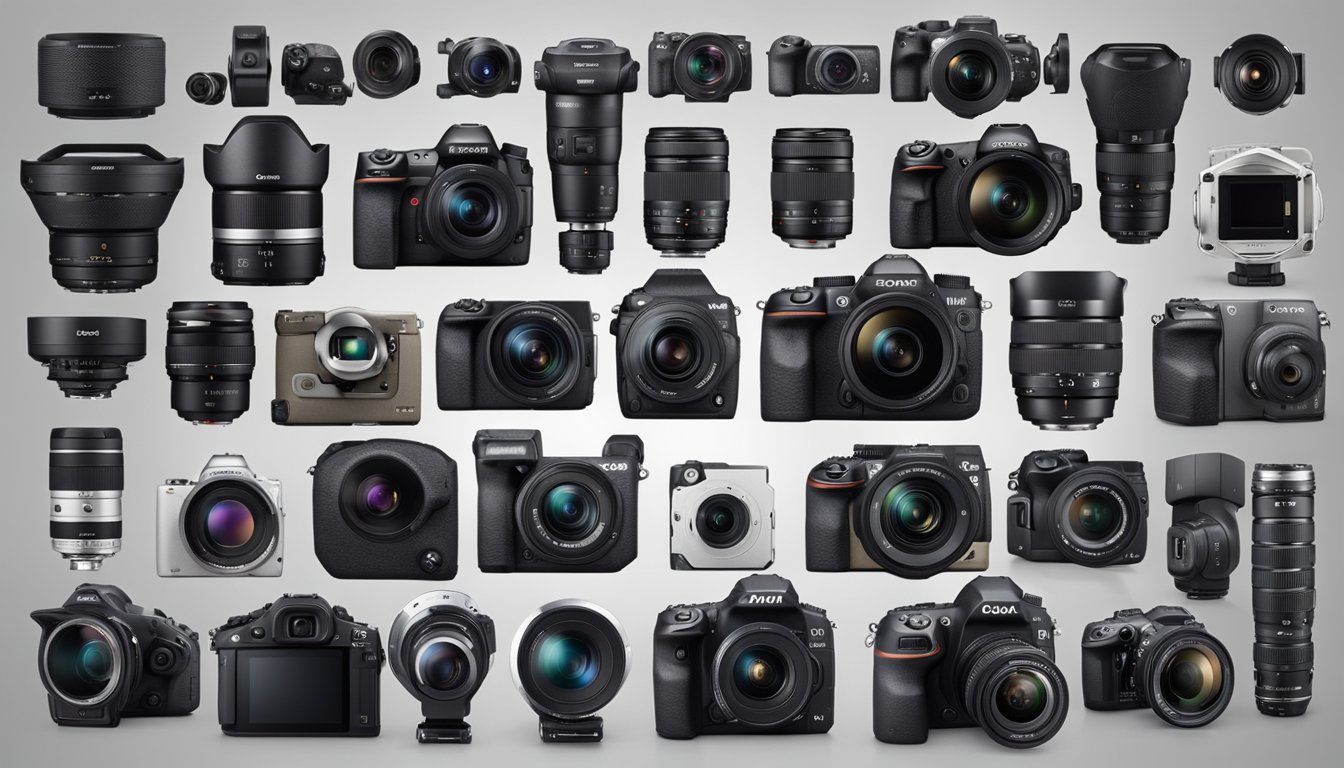360-degree cameras are revolutionizing photography and videography, allowing you to capture every angle of your surroundings in one shot. Unrestricted by the traditional frame, these devices give you a spherical view of the world, which is ideal for VR applications, real estate tours, action sports, and more. With the ability to shoot panoramic images and videos, they offer an immersive experience like no other.
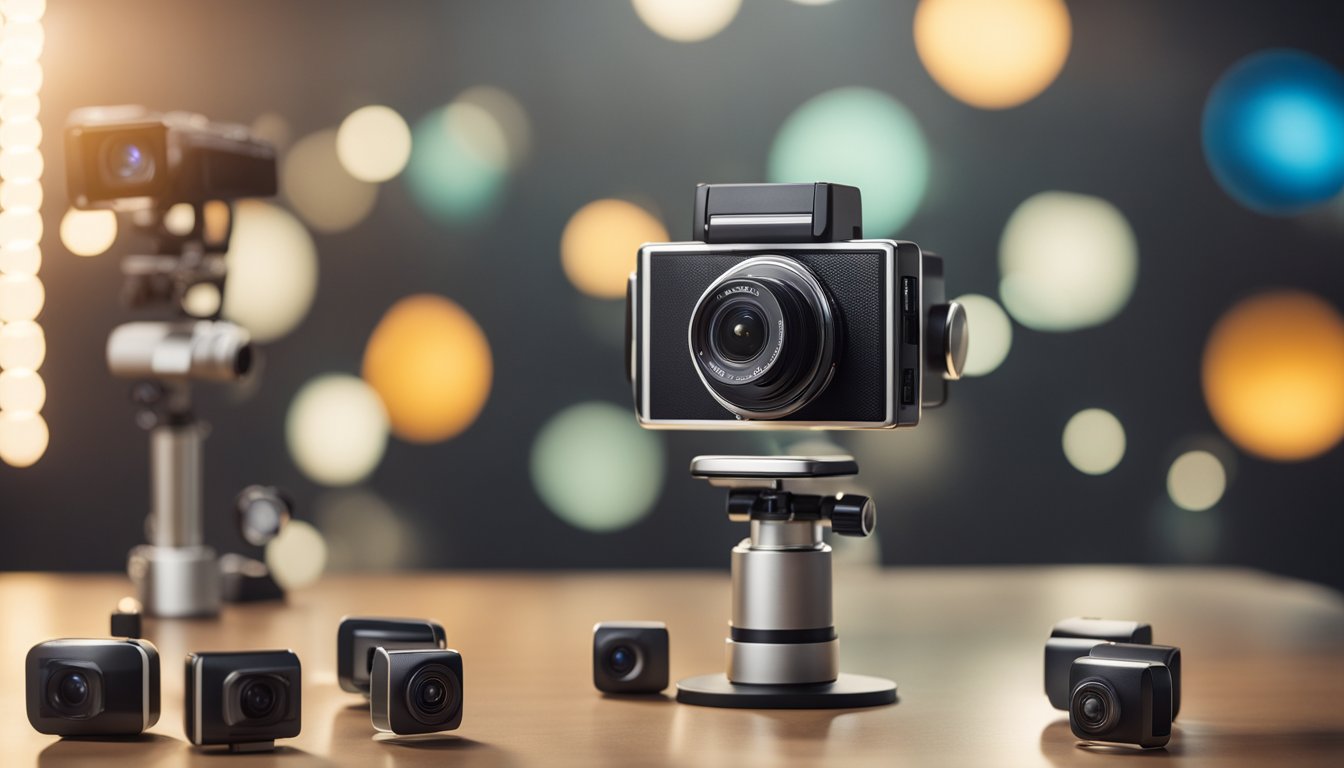
When looking for the best 360 cameras, you should consider key features like video resolution, image stabilization, water resistance, and software compatibility. High-resolution capabilities, like 5.7K video, ensure crisp and detailed imagery. Cameras like the Insta360 X3 are praised for their excellent video quality and stabilization features, making them top choices for both enthusiasts and professionals alike. Moreover, seamless software integration is crucial for editing and sharing content, while innovations in camera technology continue to expand the possibilities of what you can capture and create.
Key Takeaways
- 360-degree cameras capture a full spherical view, providing an immersive experience.
- Important features include high-resolution video, image stabilization, and software compatibility.
- Cutting-edge models and technology innovations are enhancing the capabilities of 360 cameras.
Overview of 360 Cameras
https://www.youtube.com/watch?v=gStdXBJ9cGY&embed=true
360 cameras, your essential tool for immersive photography, let you capture the world in a unique way. Instead of a limited field of view, 360-degree cameras enable you to grab every angle of a scene in either photo or video format. This means that you, as the viewer, can look around within the image or footage, truly placing yourself in the center of the action.
What’s excellent about these devices is their versatility. Whether used for 360 photos or 360 videos, they serve a broad range of purposes, from real estate tours to action-packed adventure vlog content. The latest models boast user-friendly interfaces and seamless integrations with smartphones and editing software.
When considering best 360 cameras, key features often include:

- Resolution: Higher resolution means crisper images.
- Durability: Some cameras are water-resistant or even waterproof.
- Stabilization: Essential for clear, non-shaky content.
Here’s a quick look at what you might want in a 360 camera:
| Feature | Why It Matters |
|---|---|
| High Resolution | For detailed images and videos |
| Water Resistance | To shoot in all weather conditions |
| Image Stabilization | For smooth, professional-looking content |
To help you along, we’ve gathered info from reputable sources like TechRadar, Tom’s Guide, and Digital Camera World, ensuring you have expert-backed recommendations at your fingertips.
Key Features to Consider
When choosing a 360 camera, it’s vital to focus on certain features that can make or break your experience. These elements determine not only the quality of your content but also how well your device will perform in varying conditions.
Resolution and Image Quality
Your 360 camera’s resolution is paramount as it impacts the image and video quality. Look for cameras offering 5.7K video or more, which provides crisp, detailed footage for an immersive experience. 4K resolution is a good baseline, but higher resolutions like 8K allow for sharper images and more flexibility in post-production. Larger sensor sizes contribute to better photo quality, especially in situations with low light. Additionally, effective image stabilization or stabilisation technology is essential to ensure smooth, professional-looking results even when you’re on the move.
Durability and Build
« Allie 360 Camera Review: Unveiling the Future of Immersive Photography
Best 360 Camera for VR: Top Picks for Immersive Experiences »
A camera’s durability and build quality are crucial if you’re an adventurer or travel vlogger. Cameras that boast waterproof features or at least water resistance mean you’re safe to capture moments in a variety of environments. A solid, rugged build is ideal for withstanding the elements and the occasional drop. Look for a model that balances a robust design with a lightweight feel for easy portability.
Battery Life and Performance
Lastly, consider the battery life and performance of the camera. Longer battery life means more time shooting and less time charging. Check the specs to ensure your camera can handle extended shooting sessions. Good performance is also key, which often comes from a combination in quality build and software optimization. A smooth operating experience with minimal lag is essential when you’re trying to capture moments quickly and efficiently.
Selecting the right 360 camera involves weighing these features carefully to match your specific needs and preferences.
Top 360 Cameras of 2023
https://www.youtube.com/watch?v=oTYqe2fLq7E&embed=true
In the realm of 360 cameras, your options range from professional-grade devices with exceptional quality to budget-friendly models that don’t skimp on fun. Whether you’re an adrenaline junkie capturing action shots or a professional seeking impeccable panoramic imagery, there’s a camera tailored just for your needs this year.
Professional Picks
If professional quality is what you’re after, the Insta360 Pro 2 stands out due to its 8K capabilities and robust feature set. The Ricoh Theta Z1, with its 1-inch sensor, promises crisp images and detailed stitching that pro-level work demands. These cameras aren’t just powerful; they’re designed to offer precision and reliability when every detail counts.
- Insta360 Pro 2
- 8K Video Capture
- Six Fisheye Lenses
- Ricoh Theta Z1
- 1-inch Dual Sensors
- 4K Video Recording
Best for Action Sports
For those of you who love to capture heart-pumping action, the GoPro Max is a standout. This action camera isn’t just rugged; it allows for immersive live-streaming to make your audience feel like they’re part of the action. Its Max HyperSmooth technology ensures your action videos are stable, no matter how rough the ride gets.
- GoPro Max
- Waterproof & Durable
- Max HyperSmooth Stabilization
Budget-Friendly Options
Don’t let a tight budget hold you back from diving into 360-degree photography. Cameras like the Samsung Gear 360 and Ricoh Theta SC2 are both affordable and user-friendly, perfect for beginners or those not wanting to break the bank. With decent video quality and easy-to-use interfaces, these cameras prove that 360-degree creativity is accessible to everyone.
- Samsung Gear 360
- Dual 180° Lenses
- 4K Video Capabilities
- Ricoh Theta SC2
- High-resolution images
- Under $300 Price Point
Software Integration
When it comes to getting the most out of your 360 camera, software integration is a vital part of the experience. It determines how smoothly you can edit your VR content and the ease with which you can connect to mobile apps to share your immersive stories.
Editing Software Essentials
Choosing a 360 camera that’s supported by robust editing software is crucial for creating professional-quality VR content. Many cameras, like the Ricoh Theta series, come with their own proprietary software designed to stitch, edit and view 360 footage seamlessly. Here’s what to look for:
- Compatibility: Ensure the software is compatible with your operating system, whether it’s Windows or macOS.
- Features: Look for key editing features such as stabilisation, colour correction, and horizon levelling to enhance your VR content.
Mobile App Connectivity
For those constantly on the move, quick connectivity between your 360 camera and mobile app is essential. Whether you’re using an Android device or other smartphones, the app becomes your on-the-go editing suite.
- Instant Transfer: The camera should allow for direct Wi-Fi connection to apps like the Insta360 series, enabling you to transfer and edit footage swiftly.
- Live Preview: Some apps offer a live preview function, letting you frame and shoot without guesswork.
- Sharing Features: A good app allows you to share your creation directly to social platforms right from your phone.
Innovations in Camera Technology
https://www.youtube.com/watch?v=UszgxgBxofc&embed=true
As camera tech rapidly evolves, you’re witnessing a remarkable shift in how content is captured and experienced. Modular camera systems and significant progress in virtual reality and 3D are pushing the boundaries of traditional photography and videography.
Modular Cameras
Modular design in cameras, like the Insta360 ONE R, represents a leap forward in flexibility and functionality. This means you can switch between various lenses—including a 4K Boost Lens and a 360-degree lens module—on a single camera body. By using a modular system, your camera adapts to different shooting scenarios, ensuring you always have the right tools for capturing high-resolution content.
Advancements in VR and 3D
The emergence of cameras like the Insta360 X3 is an indication of how far 360-degree technology has come, enhancing both VR and 3D experiences. These cameras don’t just capture flat images; they create immersive environments that make you feel like you’re right there in the scene. With the capability to shoot in 5.7K resolution, cameras crafted for VR and 3D make your content not just watchable, but virtually livable.
Usage Scenarios
360-degree cameras have revolutionized various industries by allowing you to capture every angle of a scene in a single shot. When you’re considering a 360 camera, it’s crucial to understand how these devices can fit into your workflow and enhance your projects.
Real Estate and Virtual Tours
In real estate, offering virtual tours is a game-changer. Your clients can explore properties at their leisure, getting a feel for the space without physical visits. 360 video plays a pivotal role here, enabling immersive experiences that can be viewed on YouTube or embedded on listings. For example, cameras like the Insta360 X3 are perfect for creating high-quality walkthroughs that prospective buyers love.
Social Media and Content Creation
As a content creator on social media, you’re always looking for ways to stand out and engage with your audience. 360-degree cameras offer a unique way to create interactive content that can captivate viewers. Whether you’re doing live-streaming events on platforms like YouTube or posting creative shots on Instagram, cameras such as the GoPro Max can help you capture every angle, ensuring your followers won’t miss a thing.
Camera Accessories
https://www.youtube.com/watch?v=Bee3ycTjI1Q&embed=true
When you dive into the world of 360 cameras, the right accessories can greatly enhance your shooting experience. They can extend battery life, stabilize your camera for live streaming, and offer new perspectives when mountable on drones or action cams.
Essential Mounts and Tripods
Your 360 camera needs a sturdy base to capture those immersive shots. A reliable tripod is indispensable, whether you’re aiming for a stationary panorama or going for a time-lapse. For more dynamic shots, consider mountable options like suction cups or clamp mounts, which can attach to a variety of surfaces, offering you creative flexibility.
- Tripods: Key for stability and precision shots.
- Lightweight and compact for travel.
- Extendable legs and adjustable heads for versatile angles.
- Mounts: Enhances camera utility.
- Helmet mounts for first-person perspectives.
- Suction mounts for attaching to vehicles.
Additional Gear for Professionals
If you’re aiming for professional quality, additional hardware can help elevate your results. Extended battery packs ensure you don’t run out of juice during important shoots. Meanwhile, live stream capabilities may require specific attachments for seamless integration. If you pair your 360 camera with drones, ensure the mount is secure and the drone’s hardware supports the camera’s weight and balance requirements.
- Extended Battery Life: Prolongs shooting time.
- Portable charging cases or battery grips.
- Battery life indicators for on-the-go power management.
- Drones and Action Cams: Opens up aerial and action-packed possibilities.
- Drone mounts designed specifically for 360 cameras.
- Action cam accessories to withstand harsh conditions.
Keep in mind that selecting the right accessories will depend on your specific camera model and the type of shooting you plan to do. Always check the compatibility of accessories with your camera to avoid any inconvenience.
Photography Tips for 360 Cameras
https://www.youtube.com/watch?v=RHejHmUZR_U&embed=true
When you dive into the world of 360 photography, understanding the basics of framing and panning becomes essential. They’re key to capturing compelling spherical videos and stills that fully immerse your viewers.
Optimal Framing and Panning
Framing Your Shots
Framing in 360-degree photography isn’t just about what’s in front of the lens; it involves the entire sphere around the camera.
- Center of Interest: Always identify a subject or point of interest. Even in a 360 scene, having a focal point guides your viewer’s eye.
- Foreground Elements: Include objects in the foreground to give a sense of depth and scale to your images.
- Avoid the Stitch Line: Be aware of your camera’s stitch line—the area where two fields of view are joined together—and position key elements away from it for a seamless look.
Panning Techniques
Unlike traditional cameras, panning with a 360 camera doesn’t mean moving the camera itself. Instead, it’s about the motion you create in the spherical video during post-production, often referred to as overcapture.
- Smooth Transitions: Ensure your panning movements are slow and steady to prevent disorienting your audience.
- Editorial Decisions: Decide when panning brings additional value to your photo or video and use it to guide the narrative of the scene.
By mastering these techniques, your photos and videos will not only look more professional, but also provide a more engaging and immersive experience. Remember, practice makes perfect, so keep experimenting with different framing compositions and panning styles to find what works best for your 360 content.
Understanding Camera Specifications
https://www.youtube.com/watch?v=07x9yyui6UY&embed=true
When you are on the hunt for the perfect 360 camera, diving into the specs can be the deciding factor. A camera’s capability to capture crisp, vivid scenes hinges on its sensor and lens setup, so let’s zoom in on those details.
Sensor and Lens Quality
Sensor Size: The size of the camera’s sensor is crucial to its performance. Larger sensors, like a 1-inch sensor, often mean better image quality, especially in low-light conditions. They also tend to provide a wider dynamic range, which helps in capturing both the darkest and lightest parts of an image with clarity.
Video Quality: Cameras capable of shooting 12K video are at the pinnacle of resolution, but be mindful that the higher the resolution, the more storage space and processing power you’ll need. Most high-quality 360 cameras deliver between 5.7K to 8K resolution, which is ample for producing sharp, detailed footage.
Lens Quality: A robust lens not only contributes to superior image quality but also adds to the camera’s ability to capture everything in a 360-degree field with minimal distortion.
(The quality of the lens and its coatings, number of elements, and aperture size all affect the final video and image outcome.)
Remember, a compact camera can be advantageous in terms of portability, but make sure it doesn’t compromise on your image quality or dynamic range. Evaluate specifications carefully, so your camera meets your expectations for capturing your world in 360 degrees.
Connectivity Features
When evaluating the best 360 cameras, connectivity features like GPS and Wi-Fi capabilities and Live-Streaming Support are crucial. They enhance your shooting experience by allowing for easy location tagging and instant content sharing.
GPS and Wi-Fi Capabilities
Your 360 camera’s ability to connect to GPS and Wi-Fi can make a significant difference in how you capture and share your experiences. The Ricoh Theta X is notable for its GPS functionality, which allows you to geotag your images, adding a location dimension to your content. Wi-Fi connectivity is essential too, enabling you to transfer files wirelessly to your devices. Cameras like the Insta360 ONE RS 1-Inch 360 Edition offer robust Wi-Fi features for quick uploads and remote camera control.
Live-Streaming Support
Live-streaming your 360-degree content directly from your camera can captivate your audience with immersive experiences. You’ll want to ensure your camera supports live-streaming with a good Wi-Fi connection. Live stream capabilities are becoming more common and cameras like the Insta360 ONE RS 1-Inch 360 Edition facilitate real-time sharing of your adventures, making it an attractive feature for vloggers and content creators who want to engage with their audience instantly.
Brands Leading the Way
When you’re in the market for a 360 camera, two names stand out due to their innovation and quality: GoPro and Insta360.
GoPro and Insta360 Highlights
GoPro: Known for its rugged durability and exceptional quality, GoPro has made a significant mark in the 360 camera field with the GoPro Max. It boasts features like Max HyperSmooth for stability and PowerPano for panoramic shots, making it a favorite among adventurers and vloggers alike.
- Key Features:
- OverCapture for traditional video capture
- Waterproof up to 16 feet
- 5.6K resolution 360 video
Insta360: A trailblazer in 360-degree photography, Insta360 offers a range of cameras, including the pocket-sized Insta360 One X and the versatile Insta360 EVO, which captures both 180 3D and 360-degree content. Their seamless stitching software and FlowState stabilization technology give you smooth and immersive footage.
- Standout Models:
- Insta360 One X: 5.7K video, 18MP photos
- Insta360 EVO: Unique hinged design for 360 and 180 3D
Other Noteworthy Brands:
- Ricoh: The Ricoh Theta Z1 and Ricoh Theta SC2 are revered for their superb image quality and ease of use, perfect for professionals and amateurs.
- Kandao QooCam: Including the Kandao QooCam 8K, the first consumer camera to offer 8K 360 video, these cameras are cutting-edge for high-resolution enthusiasts.
- Samsung Gear 360: Although an older model, the Samsung Gear 360 (2017) is still praised for its user-friendly interface and compatibility with Samsung smartphones, making it a solid entry-level option.
Frequently Asked Questions
https://www.youtube.com/watch?v=5xds4olIjw0&embed=true
In this section, we address some common inquiries you might have when choosing a 360 camera, offering clear advice to inform your purchase.
What are the top features to consider when purchasing a 360 camera?
When selecting a 360 camera, consider resolution, field of view, stitching capabilities, and ease of use. These features will greatly affect your camera’s performance and the overall quality of the content you produce.
How does 4K resolution impact the quality of 360 camera footage?
4K resolution enhances the clarity and detail in your footage, making it more immersive. Since 360 videos are stretched over a spherical surface, higher resolutions like 4K are significant for maintaining image quality when viewed on VR headsets or during playback.
Can you recommend a 360 camera that’s suitable for motorcycle vlogging?
For motorcycle vlogging, a camera with robust mounting options, strong image stabilization, and wind-resistant audio is key. The Insta360 X3 is a popular choice among content creators for these reasons.
What’s a good 360 camera option for use in vehicles?
A compact camera with a durable build and good stabilization is ideal for use in vehicles. Consider cameras with car-specific features or modes, such as the GoPro Max — mentioned in a guide by TechRadar.
Which 360 action cameras provide the best durability and image stabilization?
Action cameras like the GoPro Max and Insta360 models are renowned for their durability and excellent image stabilization. These features are crucial for capturing smooth, high-quality footage during dynamic activities.
Are there any high-end 360 cameras that justify their price point?
High-end 360 cameras, such as the Insta360 1-Inch 360 Edition, justify their price with superior video quality, larger sensors, and advanced features suitable for professional use. These cameras often offer the best performance and feature sets available, as referenced by Shotkit’s recommendations.

